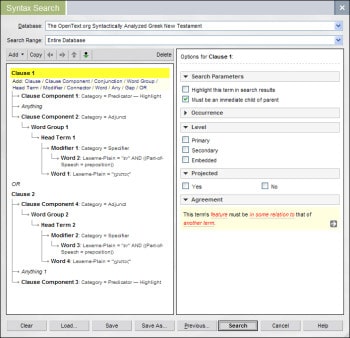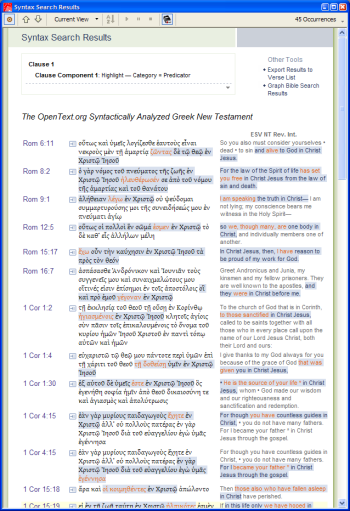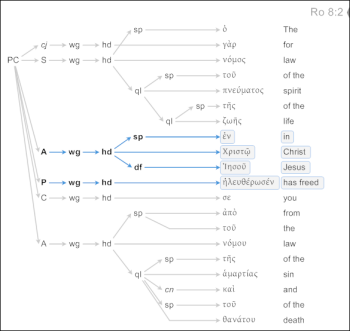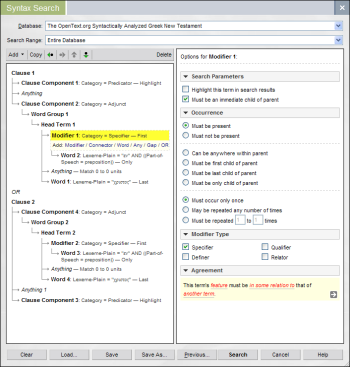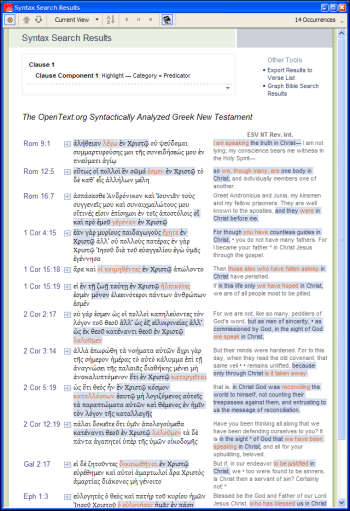Rubén Gómez, in his Bible Software Review Weblog, gives us an example of Graphical Searches in different software applications.
He uses H. Van Dyke Parunak’s article on “Computers and Biblical Studies” in Anchor Yale Bible Dictionary as a basis. The article (Vol 1 p. 1118) says:
Particularly powerful patterns are possible in a language that allows one to ask (for example) for all verbs that occur within three words of the phrase “in Christ,” without intervening verbs. A high proportion of the targets matching such a pattern will be clauses in which the prepositional phrase in fact modifies the verb.
Freedman, D. N. (1996, c2008). The Anchor Yale Bible Dictionary (1:1118). New Haven, CT: Yale.
The Anchor Yale Bible Dictionary (ABD) was published in 1992. At that time, Parunak’s underlying target result — clauses in which the prepositional phrase translated “in Christ” modifies the verb of the clause (or, better stated, locating references to the kinds of action done “in Christ”) — could only be approximated using morphological searching criteria: “for all verbs that occur within three words of the phrase ‘in Christ,’ without intervening verbs”.
But what Parunak’s target result really demands is a search that is sensitive to syntax, not just morphology and word proximity. What about when more than three words occur between the verb and the preposition? What if the prepositional phrase isn’t contiguous?
Syntax searches in Logos Bible Software 3 have no such limitations.
(Note: this post has been updated, see the bottom Update section and, of course, comments for further thoughts on syntax and morphology)
Stating the Search With Syntax Terminology
Using Logos Bible Software 3 and the OpenText.org Syntactically Analyzed Greek New Testament, we can more precisely search for Parunak’s target result: Clauses that have verbs directly modified by ?? ??????.
First, let’s talk about terms and think about how Parunak’s target result can be translated into terms used by the OpenText.org analysis. As he notes, this involves finding verbs that are modified by a prepositional phrase.
In OpenText.org, this means we are looking for a Predicator, which is the verbal element of the clause.
This also means we’re looking for an Adjunct. Adjuncts note circumstances of the action (predicator) of the clause, and include things like prepositional phrases. Inside of the Adjunct, we need to find a Word Group that contains a Head Term that contains a Modifier that is a Specifier. The specifier is a modifier that is usually either a preposition or a definite article. Thus we want a specifier that is the word ?? and is a preposition. It provides further specificity by modifying the head word of the word group. Additionally, we want the head word of the word group to be ??????.
So, in terms of the OpenText.org annotation, we want to find where a Predicator is modified by an Adjunct, and where that adjunct has a word group that has a head term containing ?? ??????, where ?? directly modifies ?????? via specification.
In other words, something that looks like this:
You may notice that Parunak’s morphological formulation of his target specifies “no intervening verbs”. This restriction is not necessary from the point of view of the syntactic search because we’re finding something much more specific. We’re finding verbs that are modified by prepositional phrases. Since the syntactic relationships are the thing being annotated and queried, we’re able to be more specific. We are not bound to a loose approximation of the search target but can instead positively state the intended target clauses with verbs modified by “in Christ”. This is why we can include the Anything attribute. Since the search is constrained to the clause, and since the search specifes the relation between clausal components, we can gloss over items between the two clausal components. We’re searching for relationships, not for word-level annotations that may or may not imply relationships.
You may also note that the search looks for hits in Predicator-Adjunct order. But notice that there is an “OR” block and the reverse order (Adjunct-Predicator) is also specified. By the way, adding the reversed set of search criteria was easily accomplished via a single copy-paste, then re-ordering the lines with the up/down arrows in the interface.
Syntax Search Results
Our OpenText.org syntax search locates 45 instances in the New Testament that match the specified criteria. Here’s a glimpse at some of the hits, note that the predicators show up in orange so you can see the different verbs used in the structure. Note also the English text (from the reverse interlinear) with appropriate English text of the Greek syntactic structure highlighted:
In looking through the results, it’s important to note that several things are found by our syntax search that wouldn’t be found by the morphologically-defined search described in ABD. Romans 8.2 (the second hit in the above graphic) is a good example. In that case, the predicator comes after the prepositional phrase: ?? ?????? ????? ???????????. Below is the Syntax Visualization of the verse with the adjunct (A) and the predicator (P) highlighted.
Another example of something a morphologically-stated query would miss is Eph 1.3, where the verb (a participle) has eight words intervening between the verb and the prepositional phrase: ? ????????? ???? ?? ???? ??????? ?????????? ?? ???? ??????????? ?? ??????.
And another example of how bounding to word-level constraints might miss things is found in 1Co 4.15. Here, the prepositional phrase has a post-positive conjunction. That, and the verb is after the prepositional phrase in this instance as well, and there are even six words between ?????? and the predicator: ?? ??? ?????? ????? ??? ??? ?????????? ??? ????
????????. This breaks most assumptions of the morphologically-stated search but still qualifies as part of the intended target, clauses where the verb is modified by ?? ??????.
Constraining Search Results Even Further
This last example brings up a further question: Does the target only include prepositional phrases of “in Christ”, or would phrases like “in Christ Jesus” or even “in the blood of Christ” also be desired? The current syntax search considers these things valid, but it doesn’t need to. We can limit to explicitly ?? ?????? if we’d like.
Updating the search to take this limit into account restricts the search hits to 14. Note that these do not include prepositional phrases of “in Christ Jesus” (or any similar constructions) but only ?? ?????? . The amended query is below.
Note that the modifier now specifies that it is the First item in the head term, the word inside the modifier specifies that it is the Only thing inside of the modifier, and the last word specifies that it is the Last thing in the head term. Also, I’ve inserted an
Anything block that has a length of zero, effectively stating that the preposition and its object must be next to each other.
And here are the updated results:
Of course, this removes some of the nice exceptions we located above, but if one is only interested in the prepositional phrase ?? ?????? (and not things like ?? ?????? ?????) modifying a verb in its clause, then this list of fourteen items may very well meet that criteria.
The Benefits of Syntactic Searching
This is why we’re so excited about using syntax in searches here at Logos. It allows an exegete to search using precise syntactic criteria (e.g., clauses with verbs modified by a prepositional phrase of ?? ??????) instead of loosely approximating syntactic criteria using word-level morphological features plus proximity.
It is good to be reminded that Parunak’s Anchor Yale Bible Dictionary article from 14 years ago pointed towards this kind of searching in this searching example. It took us 14 years, but we’ve moved forward and can now start to ask even better questions of the text and get even better results.
Update
Rubén Gómez links to this article in an update to his post with some further comments about the blurred relationship between morphology and syntax as it is implemented in analyzed editions of the Hebrew Bible and Greek New Testament. He’s right, of course. That’s why all of the syntactic databases in Logos Bible Software 3 include morphological tagging at the word level.
Morphological information is very useful and will continue to be useful. We’re using that as a foundation and building additional layers of syntactic information at the clause and phrase level, resulting in a tool that can take both morphological and syntactic criteria into account when asking questions of the text.
The above example does exactly this when it searches a Clause (syntax) for a relationship between Predicator (syntax) and Adjunct (syntax), but within the adjunct specifies morphological criteria, a Preposition (morphology) with dictionary form of ?? (morphology) which modifies via Specification (syntax) the Head Term (syntax) which has a dictionary form of ??????? (morphology).
Thanks again to Rubén for spurring these thoughts and interacting with us. Hopefully this post has been helpful in illustrating how asking questions of the text using both syntactic and morphological criteria can be done with the new Logos Bible Software 3.

